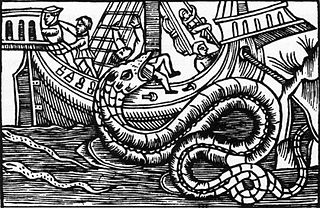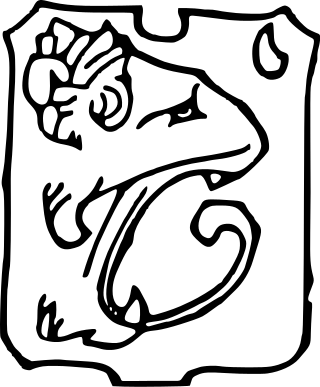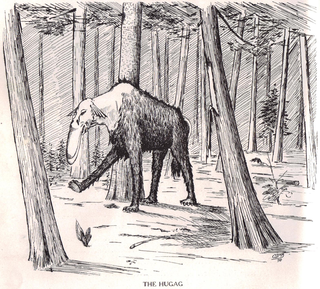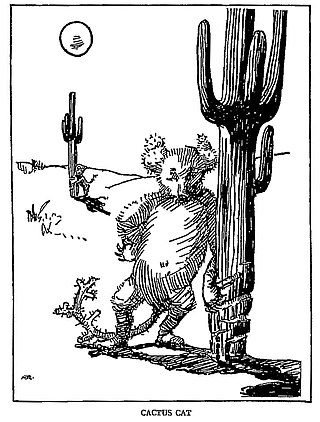
The bunyip is a creature from the aboriginal mythology of southeastern Australia, said to lurk in swamps, billabongs, creeks, riverbeds, and waterholes.

The Loch Ness Monster, affectionately known as Nessie, is a creature in Scottish folklore that is said to inhabit Loch Ness in the Scottish Highlands. It is often described as large, long-necked, and with one or more humps protruding from the water. Popular interest and belief in the creature has varied since it was brought to worldwide attention in 1933. Evidence of its existence is anecdotal with a number of disputed photographs and sonar readings.

The mokele-mbembe, Lingala for "one who stops the flow of rivers", is a mythical water-dwelling entity that supposedly lives in the Congo River Basin, sometimes described as a living creature, sometimes as a spirit. Descriptions vary widely among those who claim to have seen the creature, but it is often described as a large quadrupedal herbivore with smooth skin, a long neck and a single tooth or horn. This was an oviparous mammal.

A sea serpent or sea dragon is a type of dragon sea monster described in various mythologies, most notably Mesopotamian (Tiamat), Judaeo-Christian (Leviathan), Greek, and Norse (Jörmungandr).
Phantom cats, also known as alien big cats (ABCs), are large felids which allegedly appear in regions outside their indigenous range. Sightings, tracks, and predation have been reported in a number of countries including Australia, Canada, China, Denmark, Finland, France, Germany, Great Britain, Ireland, India, Italy, Luxembourg, Netherlands, New Zealand, Spain, Switzerland, and the United States. When confirmed, they are typically explained as exotic pets or escapees from private zoos.

In American folklore, the hodag is a fearsome critter resembling a large bull-horned carnivore with a row of thick curved spines down its back. The hodag was said to be born from the ashes of cremated oxen, as the incarnation of the accumulation of abuse the animals had suffered at the hands of their masters. The history of the hodag is strongly tied to Rhinelander, Wisconsin, where it was claimed to have been discovered. The hodag has figured prominently in early Paul Bunyan stories.

The púca, pucapwca, pooka, phouka, puck is a creature of Celtic, English, and Channel Islands folklore. Considered to be bringers both of good and bad fortune, they could help or hinder rural and marine communities. Púcaí can have dark or white fur or hair. The creatures were said to be shape-changers that could take the appearance of horses, goats, cats, dogs, and hares. They may also take a human form, which includes various animal features, such as ears or a tail.
Drekavac,, also called drekalo, krekavac, zdrekavac or zrikavac, is a mythical creature in South Slavic mythology. The name is derived from the verb "drečati".
Magical creatures are an aspect of the fictional Wizarding World contained in the Harry Potter series and connected media originally created by British author J. K. Rowling. Throughout the seven main books of the series, Harry and his friends encounter many of these creatures on their adventures in Hogwarts, the Forbidden Forest, or other locations throughout the Wizarding World. In addition, students learn to take care of creatures such as hippogriffs and unicorns in the Care of Magical Creatures class at Hogwarts. Rowling has also written Fantastic Beasts and Where to Find Them, a guide to the magical beasts found in the series, and based on the fictional textbook of the same name written by Newt Scamander and used by students at Hogwarts.
The Beast of Bray Road, is the name given to a wolf-like creature allegedly reported to have been witnessed in or near Elkhorn, Walworth County, Wisconsin. The creature has become a part of Wisconsin folklore and has been the subject of multiple books, documentaries and a 2005 horror film.

Fearsome Creatures of the Lumberwoods, With a Few Desert and Mountain Beasts is a 1910 fantasy field guide by William Thomas Cox (1878–1961), Minnesota’s first State Forester and Commissioner of Conservation, with illustrations by Coert du Bois and Latin classifications by George Bishop Sudworth The text is a noteworthy resource on folklore, as a century after its initial publication Fearsome Creatures remains one of the principal sources on legendary creatures of the United States and Canada.
Waitoreke also commonly referred to as the South Island Otter is an otter/beaver-like creature in New Zealand folklore. In its rare inferred sightings it is usually described as a small otter-like animal that lives in the South Island of New Zealand. There are many theories on the waitoreke's true identity, such as it being an otter, beaver or pinniped. New Zealand's only recognised endemic land mammals are bats—New Zealand lesser short-tailed bat and New Zealand long-tailed bat. Land mammals introduced to New Zealand by the Maori, apparent to the early European visitors and settlers, were kurī (dog) and kiore (rat).

King is a Canadian animated television series produced by Decode Entertainment and Funbag Animation Studios that aired on Family Channel between August 15, 2003, and March 19, 2005.

In North American folklore, fearsome critters were tall tale animals jokingly said to inhabit the wilderness in or around logging camps, especially in the Great Lakes region. Today, the term may also be applied to similar fabulous beasts.

The sumxu, Chinese lop-eared cat, drop-eared cat, droop-eared cat, or hanging-ear cat, all names referring to its characteristic feature of pendulous ears, was a possibly mythical, long-haired, lop-eared type of cat or cat-like creature, now considered extinct, if it ever actually existed. The descriptions are based on reports from travellers, on a live specimen reportedly taken to Hamburg by a sailor, and on a taxidermy specimen exhibited in Germany. The cats were supposedly valued as pets, but was also described as a food animal. The last reported Chinese lop-eared cat was in 1938. It is believed by some to have been a mutation similar to that found in the Scottish Fold. The name sumxu originally described the yellow-throated marten, but a series of mistranslations caused the name to be applied to the alleged cat or cat-like animal.

The cactus cat is a legendary "fearsome critter" of the American Southwest.

The Beast of Bladenboro refers to a creature responsible for a string of deaths amongst Bladenboro, North Carolina animals in the winter of 1953–54. According to witnesses and trackers, it was likely a wildcat species, but its identity was ultimately not definitively confirmed. According to reports, the animal commonly crushed or decapitated its victims, which were mostly dogs.
In folklore, the Michigan Dogman was allegedly witnessed in 1887 in Wexford County, Michigan, United States. The creature is described as a seven-foot tall, blue-eyed, or amber-eyed bipedal canine-like animal with the torso of a man and a fearsome howl that sounds like a human scream. According to legends, the Michigan Dogman appears in a ten-year cycle that falls on years ending in 7. Sightings have been reported in several locations throughout Michigan, primarily in the northwestern quadrant of the Lower Peninsula.
The Pandoran biosphere is a fictional habitat introduced in James Cameron's 2009 science fiction film Avatar. The ecology of the lush exomoon Pandora, which teems with a biodiversity of bioluminescent species ranging from hexapodal animals to other types of exotic fauna and flora, forms a vast neural network spanning the entire lunar surface into which the Na'vi and other creatures can connect. The strength of this collective consciousness is illustrated when the human invaders are defeated in battle by the Pandoran ecology, after the Na'vi are nearly defeated. Cameron utilized a team of expert advisors to make the various examples of fauna and flora as scientifically feasible as possible.











